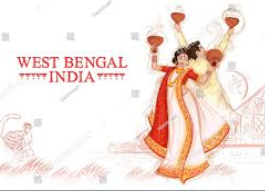Unveiling the Rhythms: Exploring the Rich Tapestry of Bengali Folk Dance
Introduction
bengali folk dance west bengal is the eastern part of India, is known for its rich cultural heritage. One of the most captivating aspects of this heritage is its traditional folk dances. These dances, deeply rooted in the cultural fabric of Bengal, offer a mesmerising glimpse into the state’s history, traditions, and emotions. In this article, we will delve into the vibrant world of Bengali folk dance, exploring its history, significance, and various forms.
A Cultural Kaleidoscope: The History of Bengali Folk Dance
Bengali folk dance, also known as “Lok Nritya” in the local language, has a history that dates back centuries. It has evolved over time, influenced by various cultural, social, and historical factors. The origins of these dances can be traced to the rural communities of West Bengal, where they were an integral part of festivals, celebrations, and daily life.
The earliest references to Bengali folk dances can be found in ancient scriptures and texts, which describe the use of dance as a form of storytelling and expression. Over the centuries, these dances evolved into a colourful tapestry of traditions, each with its unique style and significance.
The Melodic Movements: Key Forms of Bengali Folk Dance
1. Baul Nritya
Bengali Folk Dance enthusiasts often start with Baul Nritya. This dance form is deeply rooted in the mystical Baul tradition of Bengal, where wandering minstrels known as “Bauls” express their spiritual experiences through song and dance. Baul Nritya is characterised by its free-flowing movements and soul-stirring melodies.
2. Chhau Dance
Chhau Dance, originating from Purulia district in West Bengal, is a martial art form that combines dance, combat techniques, and storytelling. Performers don elaborate masks and vibrant costumes to depict various characters from mythology and folklore. The dynamic and acrobatic movements of Chhau dance leave spectators in awe.
3. Jatra Pala
Jatra Pala is a traditional Bengali folk theatre form that incorporates dance, music, and drama. It is often performed during religious festivals and celebrations. The colourful costumes, rhythmic dance sequences, and dramatic storytelling make Jatra Pala a captivating experience.
4. Santhal Dance
Santhal Dance is a tribal dance form that originated among the Santhal community of West Bengal. It is a celebration of nature and community life, featuring circular dance formations and simple yet graceful movements. The use of traditional musical instruments adds to the charm of this dance.
Significance and Cultural Impact
Bengali folk dance holds immense significance in the lives of the people of West Bengal. These dances are not merely forms of entertainment; they are an expression of identity, heritage, and emotions. Here are some key aspects of their cultural impact:
1. Preserving Tradition
Bengali folk dances play a crucial role in preserving and passing on cultural traditions from one generation to the next. They serve as a link to the past, helping communities maintain their cultural identity.
2. Festival Celebrations
During festivals like Durga Puja, Diwali, and Holi, Bengali folk dances take center stage. Communities come together to perform these dances, creating a sense of unity and celebration.
3. Storytelling
Many of these dances are a form of storytelling, conveying myths, legends, and moral lessons to the audience. They serve as a medium to educate and entertain simultaneously.
4. Social Bonding
Participating in these dances fosters social bonding and camaraderie within communities. It strengthens the sense of belonging among individuals.
The Dance of the Future: Preserving and Promoting Bengali Folk Dance
In today’s fast-paced world, it is essential to ensure that the rich heritage of Bengali folk dance continues to thrive. Efforts are being made to promote these art forms both locally and internationally. Organisations and individuals dedicated to preserving this cultural treasure have taken initiatives to:
- Documentation: Recording and documenting various forms of Bengali folk dance to create an accessible archive for future generations.
- Workshops and Training: Conducting workshops and training programs to teach the intricacies of these dances to younger generations.
- International Collaboration: Collaborating with international cultural organisations to showcase Bengali folk dance on a global platform.
- Integration in Education: Advocating for the inclusion of Bengali folk dance in the curriculum of schools and universities to ensure its perpetuity.
Conclusion
Bengali folk dance, with its diverse forms and rich history, is a testament to the cultural wealth of West Bengal. These dances continue to captivate audiences with their beauty and depth of expression. As we embrace the future, it is our responsibility to preserve, promote, and celebrate the enchanting rhythms of Bengali folk dance, ensuring that they remain an integral part of our cultural heritage for generations to come.
References:
Remember, the beauty of Bengali folk dance lies not just in its movements but in the stories it tells and the emotions it evokes. By cherishing and safeguarding these dances, we preserve a piece of our cultural identity and ensure that future generations can revel in the joy of their rhythms.
Was this response better or worse?
Better
Worse
Same
read more: Traditional Folk Dances of Nagaland: A Melodic Tapestry of…

